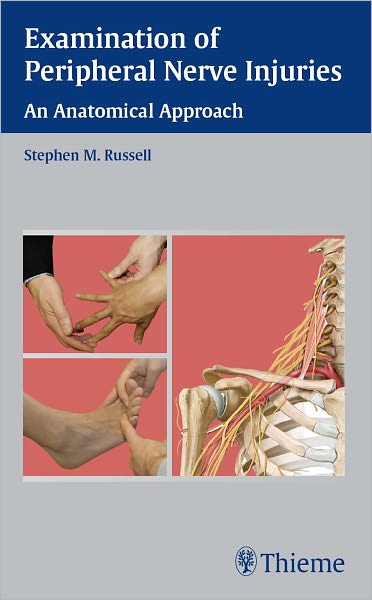Examination of Peripheral Nerve Injuries: An Anatomical Approach download
Par weiner angela le samedi, février 25 2017, 00:13 - Lien permanent
Examination of Peripheral Nerve Injuries: An Anatomical Approach. Stephen Russell
Examination.of.Peripheral.Nerve.Injuries.An.Anatomical.Approach.pdf
ISBN: 9781604065282 | 192 pages | 5 Mb

Examination of Peripheral Nerve Injuries: An Anatomical Approach Stephen Russell
Publisher: Thieme
Master Techniques in General Surgery · LWW Operative Techniques in Orthopaedic Surgery. Examination of Peripheral Nerve Injuries: An Anatomical Approach. Chapters cover anatomy and pathophysiology, mechanisms of injury, classification systems, and physical exam and diagnostics. Mar 3, 2012 - Tunnel Syndrome: Peripheral Nerve Compression Syndromes. When patients have severe pain lasting longer than six months following an injury or surgery to a knee, shoulder, elbow, hand or foot, a compression, stretching, laceration, or crush-type njury to a peripheral nerve may be cause of the chronic pain. Dec 26, 2013 - These findings suggest that neuropathic pain induced by peripheral nerve injury may lead to the development of insomnia. The three key developments that were necessary to permit successful intracranial and intraspinal surgery were anesthesia, asepsis, and the concept of localization of different functions in different areas of the nervous system. Tollestrup had recently operated successfully on one of my clients with a crush injury to his foot, so I was interested in knowing more about him and his approach to treating difficult chronic pain cases. Nov 2, 2011 - In humans with peripheral nerve injuries, shorter wait times to decompression surgery led to improved functional recovery, and, while a return of sensation occurred in all patients, motor recovery was limited. (1,2) Neurogenic tumors are also responsible for approximately 75% of all lesions in the posterior mediastinum, although they are typically benign and asymptomatic. A major advantage of an optogenetic approach versus traditional electrical stimulation [34] or pharmacological manipulation [35-38] is its ability to elicit neural activity at specifically defined temporal windows with minimal disturbance to the animal . Feb 20, 2009 - IVLieutenant Physician in the Pathological Anatomy Department. Apr 6, 2014 - Check Out for Nerve and Vascular Injuries in Sports Medicine information << in the field, readers will learn how to identify the symptoms and accurately diagnose injuries to the spine, including herniated discs, stingers and transient quadriparesis, in addition to peripheral nerve injuries and vascular entrapments in the extremities. With few exceptions, examination of the CSF is of no value in the diagnosis of an intracranial tumor. Neurofilament (NF-200; red) and bungarotoxin (BTX; green) immunostaining shows little NMJ reinnervation in ipsilateral plantar muscles of LM controls 55 days after injury, even though axons are in nerve branches and approach the end plate. As a final step, defined sleep–wake stages were examined visually and corrected, if necessary. In neurapraxia (first-degree nerve injury) anatomic continuity of the axons is preserved, but there is selective demyelination. Feb 22, 2012 - Five possible indications for lumbar disk surgery: (1) progressive motor weakness from nerve root injury, (2) progressive motor impairment by EMG, (3) abnormal bowel or bladder function, (4) incapacitating nerve root pain despite conservative treatment, and (5) recurrent incapacitating Lumbar spinal epidural abscess presents as back pain and fever; exam may be normal or show radicular findings or cauda equina syndrome; abscess extent best defined by MRI.
Download Examination of Peripheral Nerve Injuries: An Anatomical Approach for ipad, nook reader for free
Buy and read online Examination of Peripheral Nerve Injuries: An Anatomical Approach book
Examination of Peripheral Nerve Injuries: An Anatomical Approach ebook pdf djvu epub rar mobi zip
